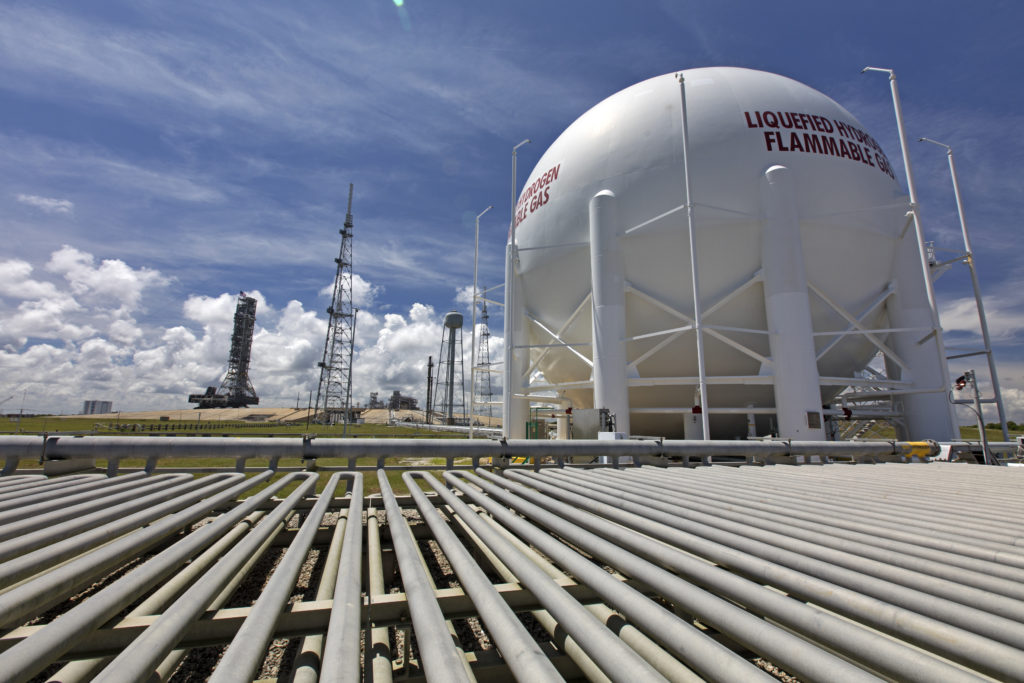In part I of this two-part series, Andy Gheorghiu touched upon the rainbow colors of hydrogen and outlined IEA’s hydrogen projections for their net-zero 2050 targets and the EU’s hydrogen strategy. Based on recent research, he raised timely questions about the shortcomings of green hydrogen and Global North’s reliance on imports. In this blog, he will talk about the potential and challenges of green hydrogen production for the Global South.

A hydrogen storage tank. (Photo by Stuart Rankin, CC BY-NC 2.0)
Africa’s Green Hydrogen Potential
The Africa Green Hydrogen Alliance (AGHA) – launched at COP26 – includes Egypt, Kenya, Mauritania, Morocco, Namibia and South Africa. Together with the UN-backed global campaigns Race to Zero and Race to Resilience and the Green Hydrogen Organisation, AGHA published a November 2022 report exploring the green hydrogen potential of its members.
Some of the key results are:
- By 2050, green hydrogen could increase the gross domestic product of the six AGHA countries by 6-12%, or up to $126bn
- The great potential for renewables in these countries could help produce green ammonia too, serving domestic and international demand for hard-to-decarbonise or hard-to-abate industrial sectors
- The EU, Japan and Korea are being seen as major markets because of their existing heavy industries and their simultaneous inability of high-scale domestic green hydrogen production for these sectors
- An estimated investment of $450-$900 billion would be needed between now and 2050 to scale-up green hydrogen production in the AGHA countries
Challenges of Green Hydrogen Production in the Global South
However, despite the obvious opportunities, challenges must be addressed too – and these go beyond finding investment.
A report that was published in October 2021 analysed the issues, challenges and opportunities to develop green hydrogen in Namibia. It highlights the following:
- Producing green hydrogen by electrolysis of water, on viable scales, requires access to large areas of low- or no-cost land, an abundance of cheap electricity, and one or several low-cost clean water sources.
- Namibia is a water-scarce country. Desalination of sea water is needed for the production of green hydrogen.
- Namibia is – despite its vast potential for wind and solar – a non-industrialised country which lacks a technical manufacturing base and is fully dependent on the import of all liquid fuels and more than one-half of its electricity demand. This creates massive dependencies for Namibia.
- Large-scale green hydrogen production which serves the Global North only should be avoided. Instead, it must be used to help Namibia meet its own development goals and should be a driver for local development.
- The ramping-up of domestic renewable energy production is needed, serving Namibia first and reducing power costs.
- An assessment of local supply chain requirements in order to improve the ability to support and benefit from emerging green hydrogen production and processing.
- National and local research, development and education must be strengthened to help establish and improve Namibian productive sectors.
- A national infrastructure master plan needs to make sure that Namibia’s water, electricity, communications, information and transport infrastructure (including ports) is systematically developed to meet national needs while benefitting from internationally funded climate-neutral developments.
A different academic analysis of the social challenges of green hydrogen in the Global South looked at the impacts of production in Brazil, another supplier for European markets. It highlights the following points:
- Production of Green Hydrogen with solar and wind power demands vast terrestrial and maritime areas.
- Conflicts are likely with traditional activities sustaining food and territorial sovereignty of artisanal fishers and native peoples.
- The transition to renewable energy sources in the Global South must not make social groups more vulnerable or increase inequalities through land and resource dispossessions.
Some key points for possible sustainable trade and production
Together with Brot für die Welt, the Heinrich-Böll-Foundation identified in a synthesis based on consultations in Africa and Latin America key criteria that must be taken into account when considering production and trade of green hydrogen from the Global South.
The report recommends:
- Green hydrogen policies need to be shaped in such a way that producer countries do not just remain exporters of raw hydrogen, but benefit from value creation along the full value chain of production and trade.
- Roadmaps must be part of national energy strategies – embedded in national sustainable development plans and nationally determined contributions
- Production must be based on strong social and sustainability standards and criteria, including respect for human rights and a “do no harm” principle regarding the environment and local communities.
- To ensure social justice, skills training for the local communities needs to be provided so that they also can obtain the new jobs created.
- The principle of free, prior, and informed consent (FPIC, as provided for in International Labour Organization (ILO) Convention 169) needs to be respected not only for marginal and minority communities, but also all affected populations.
- To ensure the green hydrogen trade runs smoothly, a certification, tracking, and accounting system is needed, as well as a harmonized definition of green hydrogen
Conclusion:
Green hydrogen is increasingly appearing to be one of few options for the industrial sectors to actually decarbonise their business model. At the same time, it is equally clear that the Global North’s heavy industry will rely heavily on the Global South to achieve this goal.
To avoid a new inter-dependency that mirror colonial-era patterns, the Global North must ensure that this partnership is based on equal terms and spurs on development in the Global South in a profound sustainable way – while simultaneously tackling global warming. Given the level of planetary urgency, we must also deeply question the industries and products we can still afford in the 21st century – no matter if they are located in the Global North or South and whether they are made using green hydrogen.